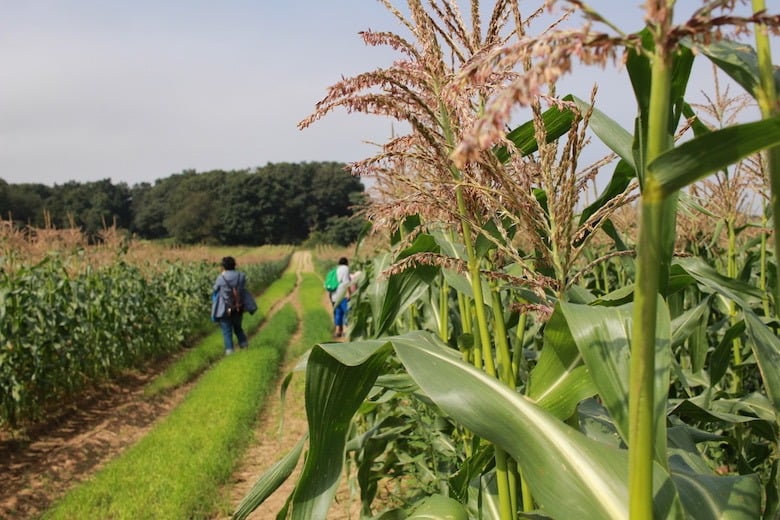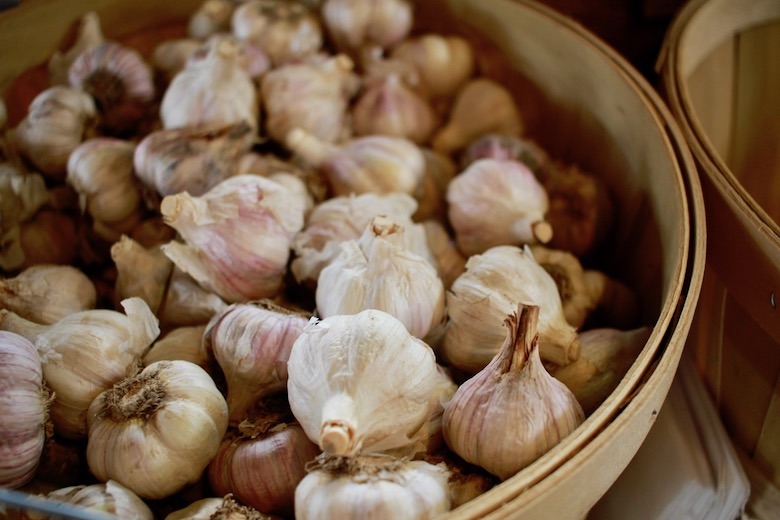Eve Kaplan-Walbrecht Talks About How to Keep Local Farmers Farming
Eve Kaplan-Walbrecht and her husband Chris own the aptly named Garden of Eve Farm on the East End of Long Island. The farm had successes when they first started selling at Long Island and New York City farmers’ markets, so soon after they opted to begin a CSA program. CSA (or Community Supported Agriculture) programs work by having members purchase a share of a farmer’s crop at the beginning of the season and then get weekly deliveries of the farmer’s product to a predetermined location throughout the growing season. Eve says being in a CSA is a good relationship for both farmer and consumer, as it gives security and predictability to the farmer since they’re paid upfront (a reliability they don’t have when partnering with a retail establishment) while members get a fresh, wholesome and diverse array of local and seasonal produce. Eve’s farm now runs 18 CSA sites, 13 of which are in New York City – a behemoth undertaking for a small family-operated farm. We visited Eve for the farm’s Garlic Festival, one of Garden of Eve’s community events, and she took some time to chat with us about what it’s like to run a CSA.
Tell us a little bit about your farm and the CSA’s origin story.
We started the farm in 2001 and quickly saw success at farmers’ markets, so we decided to launch the CSA program. The first pick-up was in Manhattan on the Upper West Side — about 80 miles from the farm — a CSA still in operation. We now run 18 CSA sites, 13 in New York City alone.
On the one hand, you pack your stuff in there and drive it to its location, so in theory it should be simple. But it’s not simple.
Customers are very supportive, and Long Island residents, whether they’re here year-round or just in summer, are in general very excited about agriculture and fresh food. And that’s really nice. And especially at the time we started at the farmers’ market, it was just the beginning of the locavore movement and the arrival of celebrity farmers.
What are some of the hurdles of delivering to 13 locations in a large urban area like NYC?
We grow about 70 types of vegetables for the CSA. It’s definitely a challenge because we plant a succession of crops. We plant in the greenhouse starting on February 1st to be ready for the June distribution, and we plant all the way through August to be ready for the November distributions, so it’s a really long season. Most farmers who are monocropping a commodity crop go out, till the field, plant, and then they can do other things in the summer and take care of the one crop, harvest, and their season is over.
But the biggest challenge for us is that we do our own trucking. Trucking is its own industry, so you don’t see any truckers farming, but farmers have to do trucking. On the one hand, you pack your stuff in there and drive it to its location, so in theory it should be simple. But it’s not simple.

We have multiple locations, we have to maintain trucks, get permits, find out what the permits are (often the hard way, after getting pulled over), we have to get drivers that have been trained well enough to drive, and then do heavy lifting, loading and unloading while maintaining the quality of the produce. Then we have to rely on the conditions at the pick-up site being good enough that produce doesn’t get damaged or sit in the sun.
Can you talk a bit about your connection to the Long Island Community and what it’s like establishing a farm there?
Town governments and the county governments will certainly say that they support farmers, but they’re not always very supportive of agriculture in a lot of very basic ways. For example, when we went to fix up the barn to be our market, which is an agricultural use by state law, we were forced to go through a really long and very expensive legal process involving two or three different governmental boards. We had at least $3,000 or $4,000 in legal bills, at least a couple thousand dollars in application fees and drafting fees for drawing. We understand there are safety regulations, but farmers are being held to the same standards that a GAP or McDonalds would be, without making the same margins that large businesses make or seeing the same customer flow.
Property taxes are also extremely high in Long Island. Even with the agricultural assessments, they’re still much higher than basically other parts of the state and the country at large. Electricity is more expensive in Long Island than anywhere else in the country, which we need for coolers, freezers, pumps and more. Trucking is very expensive since we’re isolated on an island. Most of our connection to the larger agriculture community is to Pennsylvania where resources like hay, straw, livestock and tractors are all distributed from, and they all have to come through New York City. Chris had to get oversize permits to bring a combine down from upstate and take it over the Throggs Neck. It’s not for the faint of heart. We’re not in Kansas anymore.

Membership for CSAs has been on the decline, despite growing interest in food delivery services and the move away from the supermarket shopping of yore. Has your farm experienced lower numbers in recent years?
For the most part we’re really appreciative of our urban customers. Before recently, New York was kind of a food desert in that there weren’t a lot of supermarket choices and people didn’t own cars, so people were shopping local and were really putting a lot of time and thought into providing for themselves and their families. They were considering food more deliberately and with a little bit more intention than a lot of our suburban customers that purchase whatever is most convenient by car. In New York, there are so many people in such a small area, so to have a centralized pick-up point really works well since they don’t have to go too far out of the way. In Long Island, people maybe don’t have that type of community as much directly in their geographic area.
Being a CSA member allows that farm to exist. And without that farm existing it would just be another housing development.
But with the rise of food delivery services, we have fewer members. Also, we used to have the market on organics. Most CSAs are organic, but since organics have grown a lot and become much more widely available, almost all large supermarket chains stock them now. We used to be the only place you could get organic products besides possibly a farmers’ market. We have probably 25 percent fewer members now than in 2013.
What’s your favorite thing to grow?
Kale has become kind of a joke, like: Got Kale? But kale’s a great plant! It grows all year, it grows in winter, in the heat of the summer. And Swiss chard is similar. They do the heavy lifting in the share and we often include them. Not a lot of plants are like that.
Least favorite?
It’s another joke vegetable, but kohlrabi. What are we going to do with this UFO vegetable? I’ll admit I’m not really a kohlrabi eater. I’ll eat it once in a while, but it’s not something I would reach for.
The people growing and handling our food have the most insight into the complexities of our food system and are the roots (if you’ll excuse the expression) of the system itself. So we’ll take the question directly to the farmer — why is being a member of a CSA important?
It might be a cliché, but you’re really letting your dollars do the talking. You’re putting your money into local farms that keep local farmers farming. You’re protecting the environment. Your food is fresh. You can go to those farms often, you can learn about farming, your kids can spend time on a farm. And you can drive by them and enjoy the beauty of those farms. Being a CSA member allows that farm to exist. And without that farm existing it would just be another housing development.
Follow Garden of Eve Farm on Facebook: Garden of Eve
More Reading
Meet muscadines, the native grapes of the southern U.S.
April 1, 2024
Eat more grains — and keep it local
September 29, 2023
Why We Love Photographing Our Farmers' Market Hauls
August 9, 2023
Georgia’s Peach Crop Loss Is About More Than Just Fruit
August 7, 2023
6 Recipes for Seasonal Drinks Inspired by Summer’s Bounty
June 28, 2023
Get to Know These 9 Types of Mustard Greens
June 14, 2023
The Movement to Revive Local Grains — and the Infrastructure Required to Keep It Going
June 12, 2023
A Guide to Winter Citrus Varieties
February 1, 2023
Get to Know Collard Greens
January 18, 2023
Coming Soon: More Native Foods in the National School Lunch Program
January 11, 2023
